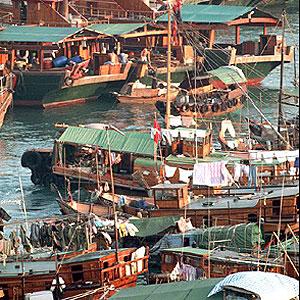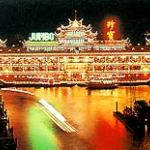From Junk to Jumbo
As a Malaysian stepping foot into Hong Kong for the very first time, I did all the usual touristy things. Shopping, shopping and more shopping. Of course, there are also many sightseeing spots that made Hong Kong a famous place for holidays. After several days of tiring shopping trips and 'no-chance encounters' with any famous TVB actors/actresses, I followed the tour group to Aberdeen.
A trip to Hong Kong would not feel complete if you do not share the experiences of the 'boat people' at the Aberdeen Fishing Village. As one of Hong Kong's oldest and most popular tourist attractions, Aberdeen gave me new insights into another culture and lifestyle. Having stayed most of my life on dry land, my perception of "life on water" changed at once.
Aberdeen used to be a little fishing village on Hong Kong Island but the scene has changed over the years. Now, you can find just as many yachts and sailboats as you would fishing trawlers and sampans (an Asian skiff usually propelled by two oars). Despite the changes, Aberdeen nonetheless remained famous amongst visitors to the country and is a scenic highlight one must not miss!
My encounter with Aberdeen took place several years ago. During that time, this harbor is home to 600-odd junks with as many as 6,000 boat people onboard the junks. Just as you would decorate your home, some of the boat people have brightly decorated trawlers. It is within these floating homes that the Aberdeen's fishing folks find shelter. From a distance, you can see hundreds and hundreds of these trawlers floating serenely over the waters, fringe by hillsides decked with woodlands, Chinese cemeteries, and tall blocks of residential apartments.
During that year, I paid a fee of HK$100 for a 30-minute boat ride through the harbor where I get to feast my eyes on the incredible array of marine life as well as the lively city-on-water scene. However, I would be lying if I say it was a totally fantastic affair. Although my eyes enjoyed the scenes, my nose did not. Probably due to the rising number of people living around the harbor, the stench from the waters was a little off-putting. Ah, then again, this would be the same smell I would get when I walk past a dumpster back home.
The short boat ride around the fishing village proves to be an eye-opener, making me wonder time and again how people could make a living and yet stay on boats all their lives. Our boatman informed us that these people will never leave their homes on the water for it would be unfruitful for them or that their boats could sink if they ever go ashore. I am not sure how true that is, but imagine raising a family in such an environment. To link this "community on water" together, wooden planks are placed to adjoin these boats. As we ride around the "homes", it amazes me to see a reasonably large family living comfortably on a tiny boat, idly chatting with their neighbors whilst a group are playing mahjong at another end. There are even several families with pet dogs and birds. On many of the boats, there are salted fishes being hung out to dry. This is, without a doubt, the main contributing factor to the stench. In wonderment, I realized that these people are oblivious to their surroundings. Perhaps they have gotten so used to being a part of the tourism agenda that they no longer cared who (or what) ride past them.
Further away from the boat people, the scene took a change and I was greeted by a lovely sight - of a huge floating restaurant whose magnificent architecture resembles that of the Imperial Palace of Ancient China. Jumbo, which means gem and treasure in the Chinese language, is so large that it can accommodate 2,300 guests at any one time. It employs over 300 staff to man the 45,000 sq. ft restaurant. Visiting the Jumbo Floating Restaurant will also enable you to view the world's largest and grandest floating restaurant, so grand that it won itself a place in the Guinness Book of Records. One of the more favorite photo-taking spots is in the VIP room, where the Imperial Chair attracts more shots than any other places in Hong Kong. The restaurant celebrates its 25th Anniversary this year. Famous for their attractively laid-out Chinese cuisine and fresh seafood, you can enjoy these succulent but slightly overpriced dishes there. To know more about this restaurant, you can check out their website here.
Back on dry land, the harbor's maritime traditions are most obvious in chandlers and seafarers' temples. One of the oldest temple, built in the year 1851, was dedicated to Tin Hau, the goddess of the sea. It is during the Tin Hau Festival in April that you will see this (otherwise shabby) temple come alive with colors and noise! In April, thousands of brightly decorated boats will converge on Aberdeen's shores.
To experience a true Hong Kong culture with its brilliant colors, outlandish sounds and perplexing odors, Aberdeen is the place for you. Despite the smell, I will be back very soon.
 ThingsAsian
ThingsAsian

















